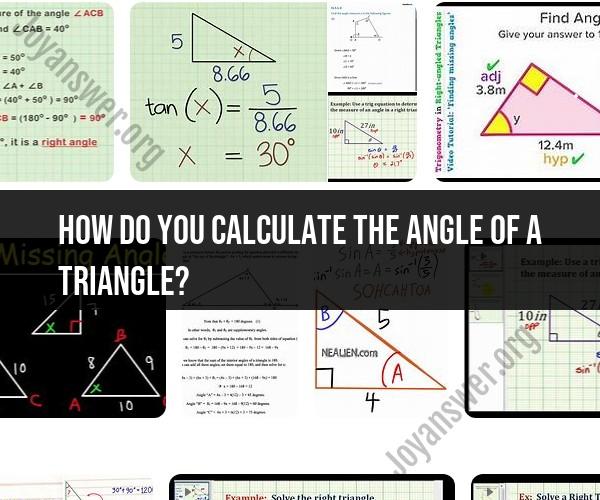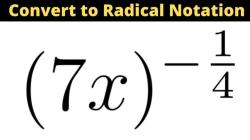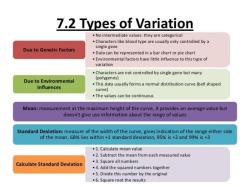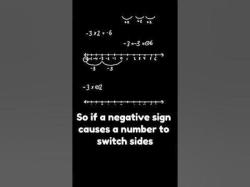How do you calculate the angle of a triangle?
To calculate the angles of a triangle, you can use various methods, depending on the information you have about the triangle. Here are some common scenarios and methods for calculating triangle angles:
For a Right Triangle (One Angle is 90 Degrees):
- If you know the lengths of the two shorter sides (legs) of a right triangle, you can use trigonometric ratios to find the angles.
- To find an acute angle, use the inverse trigonometric functions. For example, if you know the lengths of the legs (a and b) and want to find angle A, you can use the tangent function:
tan(A) = a / b. Then, take the arctan (inverse tangent) of the result to find the angle A. - For the right angle, it's 90 degrees.
For an Oblique Triangle (No Right Angle):
If you know all three side lengths (a, b, and c), you can use the Law of Cosines to find an angle. For example, if you want to find angle A opposite side a, use the formula:
cos(A) = (b² + c² - a²) / (2bc). Then, take the arccos (inverse cosine) of the result to find angle A.If you know two side lengths (a and b) and the included angle (C), you can use the Law of Cosines:
c² = a² + b² - 2ab * cos(C). Then, to find angle A, use the inverse cosine:cos(A) = (b² + c² - a²) / (2bc), and take the arccos of the result.
For a Special Right Triangle (e.g., 30-60-90 or 45-45-90):
- In these cases, the angles can be calculated easily because the side lengths have specific ratios.
- For a 30-60-90 triangle, the angles are 30 degrees, 60 degrees, and 90 degrees. The side lengths are typically in the ratio 1:√3:2.
- For a 45-45-90 triangle, the angles are 45 degrees, 45 degrees, and 90 degrees. The side lengths are typically in the ratio 1:1:√2.
For an Arbitrary Triangle (Given Some Angle-Side Combinations):
- If you know two angles and the included side (ASA or AAS), you can find the third angle using the fact that the sum of the angles in a triangle is always 180 degrees.
- If you know two sides and the included angle (SAS), you can use the Law of Sines or Law of Cosines to find the other angles.
Using Trigonometric Functions:
- In general, if you know the lengths of two sides and the included angle, you can use trigonometric functions like sine, cosine, and tangent to calculate the other angles.
It's important to have enough information about the triangle to calculate the angles accurately. The method you choose depends on the given data and the type of triangle you are dealing with.
Calculating Triangle Angles: Methods and Formulas
There are a number of different methods and formulas that can be used to calculate triangle angles. The most common methods include:
- The Angle Sum Theorem: The Angle Sum Theorem states that the sum of the angles in a triangle is always 180 degrees. This theorem can be used to calculate the missing angle in a triangle, given the measures of the other two angles.
- The Pythagorean Theorem: The Pythagorean Theorem states that in a right triangle, the square of the hypotenuse is equal to the sum of the squares of the other two sides. This theorem can be used to calculate the measure of an acute angle in a right triangle, given the lengths of the two shorter sides.
- Trigonometry: Trigonometry is a branch of mathematics that deals with the relationships between the sides and angles of triangles. Trigonometric functions, such as sine, cosine, and tangent, can be used to calculate the angles and sides of any triangle, given enough information.
The Basics of Triangle Angle Calculation
To calculate the angles in a triangle, you need to know at least two pieces of information about the triangle. This information could be the measures of two sides, the measure of one side and the measure of one angle, or the measures of all three sides.
Once you have at least two pieces of information about the triangle, you can use one of the methods described above to calculate the missing angles.
Solving for Unknown Angles in Different Types of Triangles
The specific steps involved in solving for unknown angles in different types of triangles will vary depending on the type of triangle and the information that is known. However, the general process is the same for all types of triangles.
First, identify the type of triangle and the information that is known. Then, choose the appropriate method for calculating the missing angles. Finally, use the chosen method to calculate the missing angles.
Here are some specific examples of how to solve for unknown angles in different types of triangles:
- Right triangle: To solve for an unknown angle in a right triangle, you can use the Pythagorean Theorem or the trigonometric functions sine, cosine, and tangent.
- Acute triangle: To solve for an unknown angle in an acute triangle, you can use the Law of Sines or the Law of Cosines.
- Obtuse triangle: To solve for an unknown angle in an obtuse triangle, you can use the Law of Cosines.
Trigonometry and Angle Calculation in Triangles
Trigonometry is a powerful tool for calculating triangle angles. Trigonometric functions, such as sine, cosine, and tangent, can be used to calculate the angles and sides of any triangle, given enough information.
To use trigonometry to calculate the angles in a triangle, you need to know the following:
- The type of triangle (right, acute, obtuse, or equilateral)
- The length of at least one side of the triangle
- The measure of at least one angle of the triangle
Once you have this information, you can use the appropriate trigonometric function to calculate the other angles of the triangle.
Practical Examples and Applications of Triangle Angle Calculation
Triangle angle calculation is used in a variety of practical examples and applications, such as:
- Surveying: Surveyors use triangle angle calculation to measure the distances between points on a map.
- Construction: Construction workers use triangle angle calculation to design and build structures, such as bridges and buildings.
- Navigation: Navigators use triangle angle calculation to determine their location and to plan their course.
- Astronomy: Astronomers use triangle angle calculation to measure the distances between stars and planets.
- Robotics: Robotics engineers use triangle angle calculation to program robots to move around and perform tasks.
Triangle angle calculation is an important skill to have in a variety of fields. By understanding the different methods for calculating triangle angles, you can solve a variety of problems in the real world.













